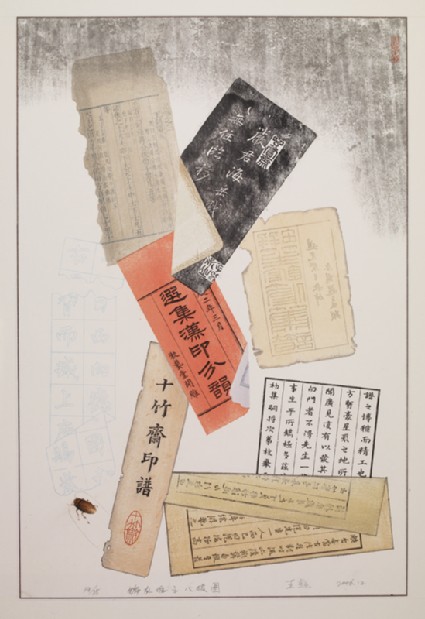Chinese Prints 1950-2006 in the Ashmolean Museum
A catalogue of the Ashmolean’s collection of Chinese prints from 1950-2006 by Weimin He and Shelagh Vainker (published Oxford, 2007).

Publications online: 129 objects
The Eight Wastes of Jinhuidui
-
Literature notes
What I have been pursuing is the impression produced between hard fruitwood and soft wuan paper-this exquisite printing impression fascintates continually.
In 1998, Wang Chao graduated from the Printmaking Department of the China National Academy of Fine Arts in Hangzhou and has remained there to carry out research on traditional Chinese woodcut printmaking. Wang Chao is one of the few professional artists still to practise the ancient woodblock method of water-soluble colour woodblock printing that flourished during the Ming period. He made his name from creating works in thread-bound book format with water soluble colour block-printing from pear wood blocks. Often combined with the blind-embossing technique, he creatively uses traditional assembled block woodcut techniques, mingled with contemporary perception, and his work has achieved international recognition. -
Description
Images of fragmented texts and paper ephemera were used in late Qing paintings, prints and on porcelain.
-
Details
- Associated place
- Date
- 2006
- Artist/maker
-
Wang Chao (born 1974) (printmaker)
- Material and technique
- multi-block woodcut, printed with water-soluble ink
- Dimensions
-
sheet 100 x 65.5 cm (height x width)
print 68 x 45 cm (height x width)
- Material index
- Technique index
- Object type index
- No. of items
- 1
- Credit line
- Purchased, 2007.
- Accession no.
- EA2007.55
-
Further reading
Weimin He, and Shelagh Vainker, Chinese Prints 1950-2006 in the Ashmolean Museum (Oxford: Ashmolean Museum, 2007), no. 126 on p. 137, illus. p. 137
Glossary
porcelain
-
porcelain
Ceramic material composed of kaolin, quartz, and feldspar which is fired to a temperature of c.1350-1400⁰c. The resulting ceramic is vitreous, translucent, and white in colour.
Past Exhibition
see (1)-

The Past in the Present: Script and Archaism in Modern Chinese Art
(from 6th Oct 2010 until 27th Feb 2011)
Location
-
- currently in research collection
Objects are sometimes moved to a different location. Our object location data is usually updated on a monthly basis. Contact the Jameel Study Centre if you are planning to visit the museum to see a particular object on display, or would like to arrange an appointment to see an object in our reserve collections.
Publications online
-

Chinese Prints 1950-2006 in the Ashmolean Museum
What I have been pursuing is the impression produced between hard fruitwood and soft wuan paper-this exquisite printing impression fascintates continually.
In 1998, Wang Chao graduated from the Printmaking Department of the China National Academy of Fine Arts in Hangzhou and has remained there to carry out research on traditional Chinese woodcut printmaking. Wang Chao is one of the few professional artists still to practise the ancient woodblock method of water-soluble colour woodblock printing that flourished during the Ming period. He made his name from creating works in thread-bound book format with water soluble colour block-printing from pear wood blocks. Often combined with the blind-embossing technique, he creatively uses traditional assembled block woodcut techniques, mingled with contemporary perception, and his work has achieved international recognition.
Notice
Object information may not accurately reflect the actual contents of the original publication, since our online objects contain current information held in our collections database. Click on 'buy this publication' to purchase printed versions of our online publications, where available, or contact the Jameel Study Centre to arrange access to books on our collections that are now out of print.
© 2013 University of Oxford - Ashmolean Museum

